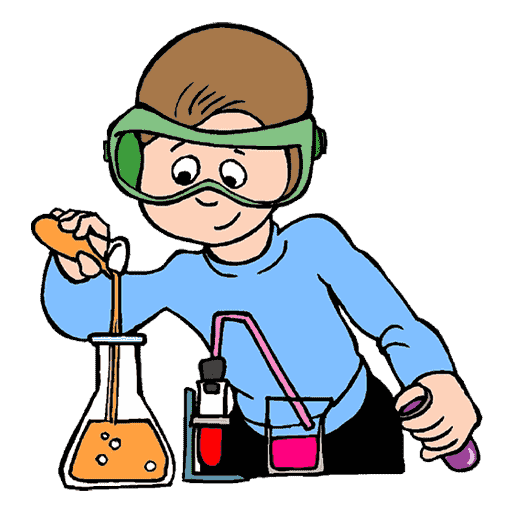Class 12th Chemsitry - Amines Case Study Questions and Answers 2022 - 2023
By QB365 on 08 Sep, 2022
QB365 provides a detailed and simple solution for every Possible Case Study Questions in Class 12 Chemsitry Subject - Amines, CBSE. It will help Students to get more practice questions, Students can Practice these question papers in addition to score best marks.
QB365 - Question Bank Software
Amines Case Study Questions With Answer Key
12th Standard CBSE
-
Reg.No. :
Chemistry
-
Read the passage given below and answer the following questions:
When the mixture contains the three amine salts (1°, 2° and 3°) along with quaternary salt, it is distilled with KOH solution. The three amines distill, leaving the quaternary salt unchanged in the solution. Then the mixture of amines is separated by fractional distillation, Hinsbergs method and Hoffmann's method.
The following questions are multiple choice questions. Choose the most appropriate answer:
(i) Hinsberg reagent is(a) aliphatic sulphonyl chloride (b) phthalamide (c) aromatic sulphonyl chloride (d) anhydrous ZnCl2 + conc. HCl. (ii) Primary amine with Hinsberg's reagent forms
(a) N-alkyl benzene sulphonamide soluble in KOH solution (b) N-alkyl benzene sulphonamide insoluble in KOH solution (c) N, N-dialkyl benzene sulphonamide soluble in KOH solution (d) N, N-dialkyl benzene sulphonamide insoluble in KOH solution. (iii) To separate amines in a mixture Hoffmann's method is used. The Hoffmann's reagent is
(a) benzenesulphonyl chloride (b) diethyloxalate (c) benzeneisocyanide (d) p-toulenesulphonic acid. (iv) 3o amines with Hinsberg's reagent give
(a) no reaction (b) product which is same as that of 10 amine (c) product which is same as that of 2° amine (d) products which is a quaternary salt. (a) -
Read the passage given below and answer the following questions:
A mixture of two aromatic compounds (A) and (B) was separated by dissolving in chloroform followed by extraction with aqueous KOH solution. The organic layer containing compound (A), when heated with alcoholic solution of KOH produce C7H5N (C) associated with unpleasant odour.
The following questions are multiple choice questions. Choose the most appropriate answer:
The reaction of (A) with alcoholic solution of KOH to produce (C) of unpleasant odour is called(a) Sandmeyer reaction (b) Carbylamine reaction (c) Ullmann reaction (d) Reimer-Tiemann reaction (ii) The alkaline aqueous layer (B) when heated with chloroform and then acidified give a mixture of isomeric compounds of molecular formula C7H6O2. (B) is
(a) C6H5CHO (b) C6H5COOH (c) C6H5CH3 (d) C6H5OH (iii) In the chemical reaction, \(\mathrm{CH}_{3} \mathrm{CH}_{2} \mathrm{NH}_{2}+\mathrm{CHCl}_{3}+3 \mathrm{KOH} \longrightarrow(A)+(B)+3 \mathrm{H}_{2} \mathrm{O},\) the compounds (A) and (B) are respectively
(a) C2H5NC and KCI (b) C2H5CN and KCI (c) CH3CH2CONH2 and KCI (d) C2H5NC and K2CO3 (iv) Direct nitration of an aromatic compound (A) is not feasible because
(a) the reaction cannot be stopped at the mononitration stage (b) a mixture of o, m and p-nitroaniline is always obtained (c) nitric acid oxidises most of the aromatic compound to give oxidation products along with only a small amount of nitrated products (d) all of the above
(a) -
Read the passage given below and answer the following questions:
The amines are basic in nature due to the presence of a lone pair of electron on N-atom of the -NH2 group, which it can donate to electron deficient compounds. Aliphatic amines are stronger bases than NH3 because of the +1 effect of the alkyl groups. Greater the number of alkyl groups attached to N-atom, higher is the electron density on it and more will be the basicity. Thus, the order of basic nature of amines is expected to be 3° > 2° > 1°, however the observed order is 2° > 1° > 3°. This is explained on the basis of crowding on N-atom of the amine by alkyl groups which hinders the approach and bonding by a proton, consequently, the electron pair which is present on N is unavailable for donation and hence 3° amines are the weakest bases. Aromatic amines are weaker bases than ammonia and aliphatic amines. Electron -donating groups such as -CH3 , -OCH3 , etc. increase the basicity while electron-withdrawing substitutes such as -NO2 , -CN, halogens, etc. decrease the basicity of amines. The effect of these substituents is more at p than at m-positions.
The following questions are multiple choice questions. Choose the most appropriate answer :
(i) Which one of the following is the strongest base in aqueous solution?(a) Methyl amine (b) Trimethyl amine (c) Aniline (d) Dimethyl amine (ii) Which order of basicity is correct?
(a) Aniline> m-toluidine > o-toluidine (b) Aniline> o-toluidine > m-toluidine (c) o-toluidine> aniline> m-toluidine (d) o-toluidine < aniline < m-toluidine (iii) What ts the decreasing order of basicity of primary, secondary and tertiary ethylamines and NH3?
(a) NH3 > C2H5NH2 > (C2H5)2NH > (C2H5)3N (b) (C2H5)3N> (C2H5)2NH > C2H5NH2 > NH3 (c) (C2H5)2NH >C2H5NH2 > (C2H5)3N > NH3 (d) (C2H5)2NH> (C2H5)3N > C2H5NH2 > NH3 (iv) Choose the correct statement.
(a) Methylamine is slightly acidic. (b) Methylamine is less basic than ammonia. (c) Methylamine is a stronger base than ammonia. (d) Methylamine forms salts with alkalie (a) -
Read the passage given below and answer the following questions:
Amines are alkyl or aryl derivatives of ammonia formed by replacement of one or more hydrogen atoms. Alkyl derivatives are called aliphatic amines and aryl derivatives are known as aromatic amines. The presence of aromatic amines can be identified by performing dye test. Aniline is the simplest example of aromatic amine. It undergoes electrophilic substitution reactions in which - NH2 group strongly activates the aromatic ring through delocalisation oflone pair of electrons of N-atom. Aniline undergoes electrophilic substitution reactions. Ortho and para positions to the -NH2 group become centres of high electrons density. Thus, -NH2 group is ortho and para-directing and powerful activating group. The following questions are multiple choice questions.
Choose the most appropriate answer:
(i) Cyclohexylamine and aniline can be distinguished by(a) Hinsberg test (b) carbylamine test (c) Lassaigne test (d) azo dye test (ii) Which of the following compounds gives-dye test?
(a) Aniline (b) Methyl amine (c) Diphenyl amine (d) Ethyl amine (iii) Oxidation of aniline with manganese dioxide and sulphuric acid produces
(a) phenylhydroxylamine (b) nitrobenzene (c) p-benzoquinone (d) phenol. (iv) Aniline when treated with conc, HNO3 and H2SO4 gives
(a) phenylhydroxylamine (b) m-nitroaniline (c) p-benzoquinone (d) nitrobenzene. (a) -
Read the passage given below and answer the following questions:
Amines are basic in nature. The basic strength of amines can be expressed by their dissociation constant, Kb or pKb.
\(\mathrm{RNH}_{2}+\mathrm{H}_{2} \mathrm{O} \rightleftharpoons \mathrm{RNH}_{3}^{+}+\mathrm{OH}^{-}\)
\(K_{b}=\frac{\left[R \mathrm{NH}_{3}^{+}\right]\left[\mathrm{OH}^{-}\right]}{\left[R \mathrm{NH}_{2}\right]} \text { and } \mathrm{p} K_{b}=-\log K_{b}\)
Greater the Kb value or smaller the pKb value, more is the basic strength of amine. Aryl amines such as aniline are less basic than allphatic amines due to the involvement of lone pair of electrons on N-atom with the resonance in benzene. In derivatives of aniline, the electron releasing groups increase the basic strength while electron withdrawing groups decrease the basic strength. The base weakening effect of electron withdrawing group and base strengthening effect of electron releasing group is more marked at p-position than at m-position. o-Substituted aniline is less basic than aniline due to ortho effect and is probable due to combination of electronic and steric effect.
The following questions are multiple choice questions.Choose the most appropriate answer :
(i) Which of the following has lowest pKb value?(ii) The strongest base among the following is
(a) C6H5NH2 (b) p-NO2 - C6H4CH2NH2 (c) m-NO2 - C6H4NH2 (d) C6H5NH2 (iii) Maximum pKb value of
(c) (CH3CH2)2NH (d) (CH3)2NH (iv) Which of the following statements is not correct?
(a) Methylamine is more basic than NH3 (b) Amines form hydrogen bonds. (c) Ethylamine has higher boiling point than propane. (d) Dimethylamine is less basic than methylamine. (a) -
Read the passage given below and answer the following questions:
RCONH2 is converted into RNH2 by means of Hoffmann bromamide degradation. During the reaction amide is treated with Br2 and alkali to get amine. This reaction is used to descend the series in which carbon atom is removed as carbonate ion (CO32-). Hoffmann bromide degradation reaction can be written as :
The following questions are multiple choice questions. Choose the most appropriate answer:
(i) Hoffmann bromamide degradation is used for the preparation of(a) primary amines (b) secondary amines (c) tertiary amines (d) secondary aromatic amines. (ii) Which is the rate determining step in Hoffmann bromamide degradation?
(a) Formation of (i) (b) Formation of (ii) (c) Formation of (iii) (d) Formation of (iv). (iii) Which of the following are used for the conversion of (i) to (ii)?
(a) KBr (b) KBr + CH3ONa (c) KBr + KOH (d) Br2 + KOH (iv) What are the constituent amines formed when the mixture of (i) and (ii) undergoes Hoffmann bromamide degradation?
(a) -
Read the passage given below and answer the following questions:
Amines are produced when an alcoholic solution of ammonia and an alkyl or a benzyl halide is heated in a sealed tube at 373 K. This reaction is called ammonolysis and usually gives a mixture of primary, secondary and tertiary amines along with some quarternary ammonium salts. This reaction is an example of nucleophilic substitution reaction in which ammonia acts as a nucleophile due to the presence of a lone pair of electrons on the nitrogen atom. However this method cannot be used for the preparation of aryl amines. One of the most convenient methods for the preparation of aryl amines is reduction of nitro compounds. Aryl amines can also be prepared by reduction of nitrites or Gabriel phthalimide synthesis.
In these questions (i-iv), a statement of assertion followed by a statement of reason is given. Choose the correct answer out of the following choices.
(a) Assertion and reason both are correct statements and reason is correct explanation for assertion.
(b) Assertion and reason both are correct statements but reason is not correct explanation for assertion.
(c) Assertion is correct statement but reason is wrong statement.
(d) Assertion is wrong statement but reason is correct statement. .
(i) Assertion: Ammonolysis of alkyl halides only produces 2o amines.
Reason: Ammonolysis of alkyl halides involves the reaction between alkyl halides and alcoholic ammonia.
(ii) Assertion: Ammonolysis method cannot be used for the preparation of aryl amines.
Reason: Aryl halides are much less reactive than alkyl halides towards nucleophilic substitution reaction.
(iii) Assertion: Ammonolysis can be used to prepare pure primary amines.
Reason: Ammonolysis of haloalkanes lead to multiple ammonium salts.
(iv) Assertion: Aromatic 1p amines can not be prepared by Gabriel phthalimide synthesis.
Reason: Aryl halides do not undergo nucleophilic substitution with anion formed by phthalimide.(a) -
Read the passage given below and answer the following questions:
Aniline activates the benzene ring by increasing electron density at ortho- and para-positions. Hence, it is o-, p-directing. -NH2 group strongly activates the ring therefore it is difficult to stop the reaction at monosubstitution stage. Among electrophilic substitution reaction, direct nitration of aniline is not done to get o- and p-nitroaniline because lone pair of electrons present at nitrogen atom will accept proton from nitrating mixture to give anilinium ion which is meta-directing. Aniline with NaNO2 and HCl forms benzene diazonium chloride at very low temperature. Aromatic amines react with nitrous acid to form a yellow oily liquid known as N-nitrosoamines.
In these questions ( i-iv), a statement of assertion followed by a statement of reason is given. Choose the correct answer out of the following choices.
(a) Assertion and reason both are correct statements and reason is correct explanation for assertion.
(b) Assertion and reason both are correct statements but reason is not correct explanation for assertion.
(c) Assertion is correct statement but reason is wrong statement.
(d) Assertion is wrong statement but reason is correct statement.
(i) Assertion: Nitrating mixture used for carrying out nitration of benzene consists of cone. conc. HNO3 +conc. H2SO4 .
Reason: In presence of H2SO4 , HNO3 acts as a base and produces NO2+ ions.
(ii) Assertion: Anilinium chloride is more acidic than ammonium chloride.
Reason: Anilinium ion is not resonance-stabilised.
(iii) Assertion: Nitrobenzene can be prepared from benzene by using mixture of conc. HNO3 and conc. H2SO4 .
Reason: In the mixture,H2SO4 act as a acid.
(iv) Assertion: In strongly acidic solution, aniline becomes less reactive towards electrophilic reagents.
Reason: The amino group being completely protonated in strongly acidic solution, the lone pair of electrons on the nitrogen is no longer available for resonance.(a) -
Amines are classified as primary, secondary and tertiary amines. Primary amines cannot be obtained by ammonolysis of alkyl halide because we will get mixture of 1°, 2 c and 3° amines. Cyanides, on reduction give primary amines where as isocyanides on reduction give secondary amines. Nitro compounds, on reduction also give primary amines. Primary amines react with CHCI3 and KOH to form foul smelling isocyanide. They react with HNO2 and liberate N2 gas. They react with Hinsberg's reagent to form salt soluble in KOH. Secondary amine form yellow oily compounds with HNO2 and salt formed with C6H5SO2CI, is insoluble in KOH. 3° amines form salt soluble in water with HNO2 but does not react with C6Hs SO2CI.
Diazonium salts are prepared by reaction of Aniline with NaNO2 and conc. HCI at 0 - 5 0c. Aromatic diazonium salts are more stable because phenyl diazonium ion is stabilized by resonance. Benzene diazonium chloride can be used to prepare halo benzene, phenol, nitro benzene, benzene, p-hydroxy azo benzene (azo dye) and large number of useful compounds.
(a) Write the isomer of C3H9N which does not react with Hinsberg reagent.
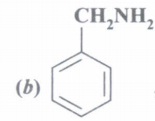 on heating with CHCI3 and KOH gives 'X'. Identify 'X'.
on heating with CHCI3 and KOH gives 'X'. Identify 'X'.
(c) Convert Aniline to phenol.
(d) Distinguish between Aniline and ethyl amine.
(e) Complete the following reaction
\(\mathrm{C}_{6} \mathrm{H}_{5} \mathrm{NO}_{2} \stackrel{\mathrm{Fe} / \mathrm{HCl}}{\longrightarrow} \mathrm{A} \frac{\mathrm{NaNO}_{2}+\mathrm{HCl}}{0-5^{\circ} \mathrm{C}} \mathrm{B}\) Identify' A' and 'B'.
(f) \(\mathrm{C}_{6} \mathrm{H}_{5} \mathrm{~N}_{2}^{+} \mathrm{Cl}^{\mathrm{CuCN}} \longrightarrow \mathrm{A} \stackrel{\mathrm{H}_{2} \mathrm{O} / \mathrm{H}^{+}}{\longrightarrow} \mathrm{B}\) Identify 'A' and 'B'.
(g) What is use of quarternary ammonium salts of long chain tertiary amines?(a) -
Organic compounds containing amine as functional group are present in wide variety of compounds namely amino acids, hormones, neurotransmitters, DNA, alkaloids, dyes etc. Drugs including nicotine, morphine, codein, heroin etc. which have physiological effects on human also contain -NH2 group in one form or another. Amines are basic in nature due to presence of lone pair of electron on nitrogen. Adrenaline hormone and ephedrine drug, both contain second amino group are used for increasing blood pressure. Novacain, a synthetic compound contains both primary ana tertiary amino group, is used as anaesthetic in dentistry. Benadryl, a widely used antihistamine drug contains tertiary amino group, Quarternary ammonium salts of long chain, tertiary amines are used as cationic detergents. Diazonium salts are used for synthesis of azodyes and useful aromatic compounds.
(a) Write the formula of tertiary amine with molecular formula C3H9N, which does not react with Hinsberg reagent?
(b) Convert Aniline to p-hydroxy azo benzene.
(c) Give one example of cationic detergent.
(d) What is formula of paracetamol, (crosin), a well known antipyretic?
(e) How will you distinguish between Aniline and Benzyl amine?(a) -
Observe the histogram showing boiling points of pentane, iso pentane, 1°,2° and 3 ° amines. Answer the questions that follow based on table and related concepts.
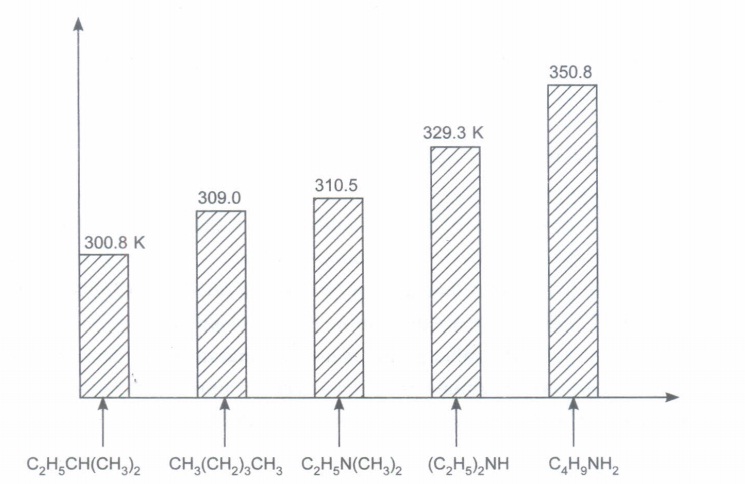
(a) Why does CH3CH2CH2CH2NH2 (1° amine) has higher boiling point than (C2H5)2NH and C2H5N(CH3 )2?
(b) Why does ethanol have higher boiling point than ethanamine?
(c) Why amines are more basic than alcohol?
(d) Why are Primary amines more soluble in water than 2° and 3° amines?
(e) Arrange the compounds shown in graph, increasing order of boiling points. Give reason.(a) -
Table relates various amines with pKb values. Study this table and answer the questions related to table and studied concepts.
Compounds pKb Ammonia 4.75 CH3NH2 3.38 (CH3)2NH 3.27 (CH3)3N 4.22 CH3CH2NH2 3.29 (C2H5 )2NH 3.00 (C2H5 )3N 3.25 C6H5NH2 9.38 C6H5NHCH3 9.30 C6H5N(CH3 )2 8.92 C6H5CH2NH2 4.70 p-nitro aniline 13.0 p- Toluidine 9.21 p-Anisidine 8.71 (a) Arrange CH3NH2 , (CH3 )NH, (CH3)3N in decreasing order of basic character in aqueous solution. Give reason.
(b) Arrange C2H5NH2, (C2H5)2NH, (C2H5)3N in decreasing order of basic character in aq. solution. Give reason.
(c) Arrange, C6H5CH2NH2, C6H5NH2 ,C6H5N(CH3)2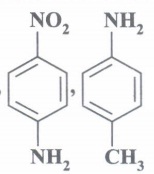 in increasing order or basic character.
in increasing order or basic character.
(d) Arrange CH3NH2 , (CH3)2NH, (CH3)3N in increasing order of basic character in gaseous state. Give reason.
(e) Why is Aniline less basic than benzyl amine?(a)
Case Study
*****************************************
Answers
Amines Case Study Questions With Answer Key Answer Keys
-
(i) (c)
(ii) (a): A primary amine forms N-alkylbenzene sulphonamidewhich because ofthe presence of an acidic hydrogen on the N-atom dissolves in aqueous KOH.
(iii) (b)
(iv) (a): Tertiary amine does not contain a replaceable hydrogen on the nitrogen atom. So, 3o amine does not react with Hinsberg's reagent. -
(i) (b) : Carbylamine reaction
C6H5NH2 + CHCl3 + 3KOH (alc.) ➝ C6H52NC + 3KCI + 3H2O
Aniline Phenyl isocyanide (C)
(A)
(ii) (d): Alkaline layer on treating with CHCl3 followed by acidification gives two is?mers having formula (C7H6O2). This is Reimer-Tiemann reaction and thus (B) is C6H5OH.
\( \mathrm{C}_{6} \mathrm{H}_{5} \mathrm{OH}+\mathrm{CHCl}_{3}+\mathrm{KOH} \stackrel{\mathrm{H}^{+}}{\longrightarrow}\\ \text { Phenol }(B) \)
(iii) (a): CH3CH2NH2 + CHCl3 + 3KOH ➝ C2H5NC + 3KCl + 3H2O
This is called carbylamine reaction.
(iv) (c): Direct nitration of aniline is not a feasible process because nitric acid oxidises most of aniline to give oxidation products along with only a small amount of nitrated products. -
(i) (d): The increasing order of basicity of the given compounds is (CH3)2NH > CH3NH2 > (CH3)3N > C6H5NH2 .Due to the +1effect of alkyl groups, the electron density on nitrogen increases and thus, the availability of the lone pair of electrons to proton increases and hence, the basicity of amines also increases. So, aliphatic amines are more basic than aniline. In case of tertiary amine (CH3)3N, the covering of alkyl groups over nitrogen atom from all sides makes the approach and bonding by a proton relatively difficult, hence the basicity decreases. Electrop withdrawing groups decrea e electron density on nitrogen atom and thereby decreasing basicity.
(ii) (d): In general, electron donating (+ R) group which when present on benzene ring (-NH2 , -OR, -R, etc.) at the para position increases the basicity of aniline.
Ortho substituted anilines are weaker bases than aniline due to ortho effect.
(iii) (d): In case of ethylamines, the combined effect of inductive effect, steric effect'and solvation effect gives the order of basic strength as
(C2H5)3N> (C2H5)2NH > C2H5NH2 > NH3
(2°) (3°) (1°)
(iv) (c) : Methyl amine is stronger base than ammonia due to electron releasing inductive effect of methyl group. -
(i) (d)
(ii) (a): Aromatic primary amines give dye test.
(iv) (b): In acidic medium aniline gets protonated to anilinium ion which is meta-directing.
-
(i) (c)
(ii) (d)
(iii) (a)
(iv) (d): Dimethylamine is more basic than methyl amine. -
(i) (a)
(ii) (d): The rate determining step is probably loss of Br- to form isocyanate as this is the slowest step.
(iv) (b): Since, the overall reaction is intermolecular, hence there will be no effect on product formation.
-
(i) (d): Reaction can be used to prepare 1°, 2°, 3° amines and finally quaternary ammonium salts.
(ii) (a)
(iii) (d): Ammonolysis cannot be used to prepare pure primary amines. This method usually gives a mixture of primary, secondary and tertiary amines along with some quaternary ammonium salts.
(iv) (a) -
\(\text { (i) }(\mathrm{a}): \mathrm{HNO}_{3}+2 \mathrm{H}_{2} \mathrm{SO}_{4} \rightleftharpoons 2 \mathrm{HSO}_{4}^{-}+\mathrm{NO}_{2}^{+}+\mathrm{H}_{3} \mathrm{O}^{+}\)
(ii)(c) : \(\mathrm{C}_{6} \mathrm{H}_{5} \mathrm{NH}_{3}^{+} \longrightarrow \mathrm{C}_{6} \mathrm{H}_{5} \mathrm{NH}_{2}+\mathrm{H}^{+}\)
anilinium ion aniline
stronger acid weaker conjugated base
Aniline is weaker base than ammonium chloride. In NH4CI or aliphatic amines, the non-bonding electron pair of N is localized and is fully available for coordination with a proton. On the other hand, in aniline or other aromatic amines, the non-bonding electron pair is delocalised into benzene ring by resonance.
But anilinium ion is less resonance stabilised than aniline.
(iii) (b)
(iv) (a) -
(a) (CH3)3N, N, N-dimethyl methanamine.
(b)
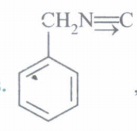 a foul smelling compound.
a foul smelling compound.
(c)

(d) Add NaNO2 and cone. HCI. Cool it to 0 to 5° C. Then add alkaline solution of phenol. Aniline gives orange dye where as ethyl amino does not.
(e) \(\begin{array}{ll} \mathrm{A}^{\prime} \text { is } \mathrm{C}_{6} \mathrm{H}_{5} \mathrm{NH}_{2} & { }^{\prime} \mathrm{B}^{\prime} \text { is } \mathrm{C}_{6} \mathrm{H}_{5} \mathrm{~N}_{2}^{+} \mathrm{Cl}^{-} \end{array}\)
(f) 'A' is C6H5CN, 'B' is C6H5COOH
(g) It is used as cationic detergents used in hair conditioners and shampoo. -
(a) (CH3)3N does not react with Hinsberg reagent.
(b)

(c)
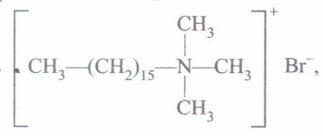 cetyltrimethyl ammonium bromide.
cetyltrimethyl ammonium bromide.
(d)
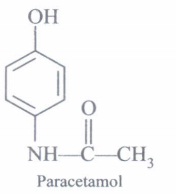
(e) Add NaNO2 and cone, HCI. Cool it to 0 - 5°C. Then add alkaline solution of phenol. Aniline will give orange, azo dye, whereas Benzyl amine does not. -
(a) It is because extent of H-bonding is more in CH3CH2CH2CH2NH2 than 2° and 3° amines.
(b) It is because H-bonds are stronger in alcohols than amines because 'O' is more electronegative than 'N'.
(c) It is because \(\stackrel{\oplus}{\mathrm{RNH}_{3}}\) is more stable than \(\underset{\mathrm{ROH2}}{\oplus}\) . +ve charge on oxygen is not stable.
(d) It is because primary amines can form H-bonds with water to more extent.
(e) C2H5CH(CH3)2 < CH3(CH2)3CH3 < C2H5N(CH3)2 < (C2H5)2NH < C4H9NH2.
Isopentane has lower boiling point that n-Pentane due to branching less surface area, less van der Waals' forces of attraction. 3° < 2° < 1° is order of boiling point in amines because extent of H-bonding increases. -
(a) (CH3)2NH > CH3NH2 > (CH3)3N, \(\because\) in tertiary amines, there is more steric hindrances.
(b) (C2H5)2NH > (C2H5)3N > C2H5NH2
It is because in 3° amine, +1 effect dominates over steric hindrances
(c)
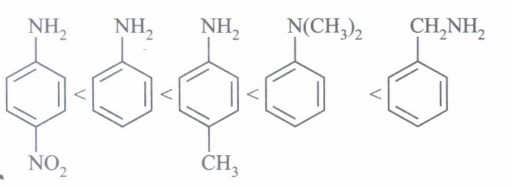
(d) (CH3)3N> (CH3)2NH > CB3NH2 (in gaseous state)
It is because electron density is maximum on 'N' in 3° amine> 2° > 1°, Stearic hindrance does not play any role.
(e) It is because C6H5 - electron withdrawing is directly attached to -NH2 in aniline but not in C6H5CH2NH2·



